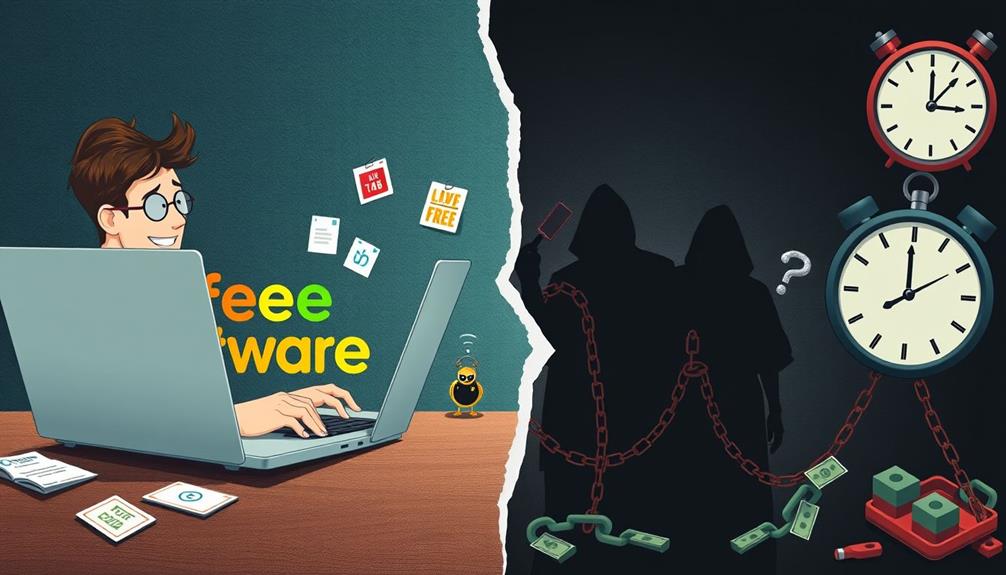To conquer workplace productivity paranoia now, focus on building a culture of trust and open communication. Regular check-ins and feedback can help ease uncertainty, as many remote workers crave clarity about their team's engagement. Set clear, measurable goals to give everyone a sense of direction. Celebrate team achievements, as recognition can significantly boost morale and channel productivity. Embrace flexible workspaces that support both collaboration and focused tasks. By addressing these areas, you'll enhance team connection and accountability, creating an environment that drives success. There's so much more to uncover that can truly elevate your workplace dynamics.
Key Takeaways
- Foster open communication through daily stand-ups to share challenges and build team connections.
- Establish clear, measurable goals to provide employees with a sense of purpose and alignment.
- Provide regular feedback and guidance to enhance employee growth and reduce feelings of paranoia.
- Recognize and celebrate employee achievements to boost morale and create a culture of appreciation.
Understanding Productivity Paranoia
Productivity paranoia often stems from a lack of visibility in remote work environments, making you question your team's engagement and performance. This uncertainty can lead to distrust, impacting morale and retention. This distrust can create a vicious cycle, where micromanagement or excessive monitoring further diminishes trust and autonomy. Such actions may inadvertently contribute to remote workers feeling isolated, as they perceive a lack of confidence in their abilities. To counteract productivity paranoia, fostering open communication and emphasizing results over activity can help build stronger, more trusting relationships.
Instead of focusing solely on appearances of busyness, encourage task completion and celebrate achievements. You'll find that clear communication about workloads and expectations is essential; 81% of workers crave guidance, but only 31% receive it.
Implementing regular feedback and daily stand-ups creates opportunities for connection and support, reducing feelings of paranoia. By establishing clear objectives and Key Results (OKRs), you provide your team with direction, fostering a sense of purpose and trust that can combat these negative feelings, ultimately enhancing productivity and collaboration.
Building a Supportive Culture
Creating a supportive culture is key to alleviating productivity paranoia and fostering an environment where employees feel valued and engaged. When you focus on building this culture, you encourage trust and collaboration.
Here are four essential elements to consider:
- Embrace Diverse Perspectives: Recognize and appreciate the unique contributions of each team member.
- Encourage Open Conversations: Foster transparency and honesty to build stronger relationships.
- Celebrate Achievements: Acknowledge individual and team successes to boost morale.
- Provide Regular Feedback: Offer constructive input to help employees grow and feel supported.
Establishing Clear Goals

Clear goals provide a roadmap for employees, helping them connect their daily tasks to the organization's broader objectives.
When you set clear, measurable goals—like Objectives and Key Results (OKRs)—you create a sense of purpose that drives performance.
By understanding how your work contributes to larger goals, you'll feel more engaged and aligned.
Regularly communicating these objectives prevents confusion and frustration, allowing you to prioritize effectively.
Documenting roles and responsibilities also clarifies expectations, reducing the risk of burnout.
Remember, it's essential to revisit these goals frequently, adjusting them as needed to stay on track.
Establishing clear goals not only boosts your productivity but also fosters a culture of accountability and trust within your team.
Designing Flexible Workspaces
Flexible workspaces adapt to diverse working styles, promoting both collaboration and focused productivity among employees. When you design an office that accommodates various preferences, you create an environment where everyone can thrive.
Consider the following elements to enhance your workspace:
- Comfortable lounge areas for informal brainstorming sessions.
- Quiet zones for deep work, allowing you to concentrate without distractions.
- Flexible furniture that can be rearranged easily to suit different tasks and team sizes.
- Technology integration that supports seamless communication and collaboration.
These features not only boost productivity but also foster a sense of belonging. By prioritizing employee needs, you'll cultivate a workplace where everyone feels valued and motivated to excel.
Embracing Hybrid Work Models

Embracing hybrid work models allows you to blend the best of both remote and in-office environments, enhancing productivity and employee satisfaction.
You can tailor your work experience to fit your personal needs, choosing when to collaborate in person and when to focus remotely. This flexibility empowers you to manage your time effectively, leading to increased motivation and creativity.
Furthermore, hybrid models foster a culture of trust and accountability, as you demonstrate your ability to deliver results without constant oversight.
By prioritizing work-life balance, you can maintain your well-being while contributing meaningfully to your organization.
Ultimately, adopting a hybrid approach positions you to thrive in a dynamic work landscape, embracing change while driving productivity and engagement.
Encouraging Open Communication
Encouraging open communication is vital for building trust in hybrid work environments, where employees may feel isolated and disconnected from their teams. By fostering an atmosphere where everyone feels heard, you can significantly enhance engagement and collaboration.
Here are four ways to promote open dialogue:
- Daily stand-ups: These brief meetings create a platform for sharing challenges and solutions, making everyone feel included.
- Feedback loops: Regularly ask for input and be receptive to suggestions to show you value their opinions.
- Transparent decision-making: Share the rationale behind decisions to build trust and reduce uncertainty.
- Social channels: Encourage informal interactions through chat platforms to strengthen team connections.
Recognizing Employee Achievements

Recognizing employee achievements not only boosts morale but also strengthens the overall workplace culture. When you take the time to acknowledge your team's hard work, you create an environment where everyone feels valued and motivated.
Simple gestures, like shout-outs during meetings or personalized notes, can make a significant impact. Celebrate milestones and accomplishments, no matter how small. This recognition fosters a sense of belonging and encourages continued effort.
Moreover, it helps combat productivity paranoia; when employees see their contributions valued, they're less likely to question their worth. By regularly highlighting achievements, you cultivate a culture of appreciation that enhances productivity and trust, ultimately leading to a more engaged and committed workforce.
Conclusion
In tackling productivity paranoia, remember the adage, 'A chain is only as strong as its weakest link.'
By fostering a supportive culture and clear communication, you not only strengthen your own resolve but also uplift your team.
Embrace flexibility, set achievable goals, and celebrate each other's achievements.
Together, you can transform anxiety into confidence, creating an environment where everyone thrives.
It's time to reclaim your focus and contribute to a more connected workplace.
You've got this!










